
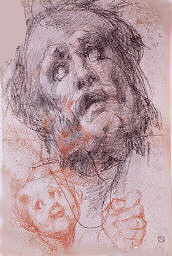 **
**
Это было, когда пески занесли последний из городов, известных в Великой Пустыне, когда не только кости,
но и воспоминания о гностиках оказались засыпанными прошлым.
Итак, однажды спокойным пустынным утром несколько египетских феллахов, среди которых находился некто
Мухаммед Али, направлялись на верблюдах к внушительной скале, которая находится в бассейне Нила в
Верхнем Египте недалеко от современного города Наг Хаммади. Феллахи искали "сабакх" -- натуральное
удобрение, которым знаменит район Наг Хаммади, вот они и остановили своих верблюдов у подножия
отдельно стоящей горы Джабал Ал-Тариф и начали копать вокруг крупного обломка скалы, упавшего сверху, в направлении
основания горы. К своему огромному удивлению, они обнаружили большой горшок с крышкой в форме миски.
Мухаммед Али долго колебался, прежде чем открыть крышку...
Мухаммед Али долго колебался, прежде чем открыть запечатанную крышку. Скорее всего, он боялся, что в
горшке может оказаться джинн, который, будучи выпущенным, снесет не только голову Мухаммеда Али, но и
скалу, под которой лежал горшок. В то же время, он подумал и о вероятности обнаружить в горшке сокровища,
о которых рассказывали многочисленные легенды, циркулировавшие в районе. В общем, любовь к золоту
пересилила страх перед джинном.
Решившись, он разбил горшок мотыгой и увидел, как из него поднимается к золотым небесам некая золотистая
субстанция.
В общем, если демифологизировать происшедшее и посмотреть на событие глазами не бедных феллахов, а
богатых скупщиков ценностей, никакой это не джинн вылетел из разбитого горшка. И не золотая пыль. Были
это всего-навсего мельчайшие кусочки папируса золотистого оттенка, которые вздумали заблестеть в свете
заходящего солнца. Ибо наш Мухаммед Али обнаружил в горшке 13 папирусных книг (Кодексов) библиотеки
Наг Хаммади, среди которых оказалось и "Евангелие от Фомы".
Еще до обнаружения указанного манускрипта ученым были известны разрозненные фрагменты цитат, которые
находили в писаниях отцов церкви, и которые отсылали читателя к документу, называемому "Евангелие от
Фомы". Мы подозреваем, что некоторые из этих свидетельств с таким же
успехом могли относиться к так
называемому "Детскому Евангелию от Фомы" – раннехристианскому документу, который представлял собою
серию легендарных сказаний о чудесных деяниях Христа-отрока. Другие полагали, что ЕоФ было написано и
использовалось манихеями – мистиками и гностическими последователями
учителя Мани.
Но не будем вдаваться в теологические споры. Нас интересует документ и его судьба.
Лишь одна книга, в которой были записаны учения Христа из Назарета, лишь единственная копия этого
уникального манускрипта, не была тронута Церковью. Никогда содержание этой книги не подвергалось
влиянию церковников, и ни в коей мере не отражает она доктрины, выработанные христианской церковью.
Эта книга – Оригинал. Независимый.
Книга состоит из неприукрашенной коллекции высказываний Иисуса, записанных его учеником Фомой,
поэтому некоторые думают, что текст написал сам Фома. В те эпические времена умели писать далеко не все.
Собственно, и Исус, видимо, не умел. Любовные письма, счета, мысли... Все это записывали скрибы, которых
можно было нанять на любом базаре. О Фоме мы знаем, что после широко известного распятия Христа около
30 года нашей эры он был назначен "эмиссаром" учения на Восток – в Сирию и Индию. В Южной Индии
сохранились традиционные представления о том, что около 52 г. н.э. Фома туда прибыл. Итак, логично
предположить, что Фома записал высказывания Христа еще до своей посольской миссии, что делает "Текст
Фомы" где-то на поколение более ранним, чем любая из книг, принятых Церковью и включенных в Новый
Завет.
Ныне нам известно, что в те далекие дни образовалась целая духовная община, которая сконцентрировалась
вокруг текста Фомы. Эта община распространяла свое влияние из Египта, захватывая Палестину, Сирию и
более удаленные страны.
Тем не менее, эта община, и в особенности, сам текст Фомы вызвали неудовольствие и, в конечном счете,
проклятие христианской церкви; так, епископ Ипполит, глава Римской Церкви (умер в начале III в.), запретил
своим последователям использовать текст Фомы, а в 367 г. епископ Афанасий Александрийский разослал
указ, в котором осуждал еретическое течение и апокрифические писания. Именно по этой причине монахи из
монастыря святого Паламона в Кенобоскии (ок. 600 км. вверх по Нилу) собрали 52 книги (12 томов) из своей
библиотеки и спрятали их в большом керамическом сосуде под огромной скалой в уже описанном месте.
Вот таким образом сокровища библиотеки последователей Фомы избегли нездорового интереса со стороны
борзых ищеек Архиепископа, избегли унижения и разрушения, постигших их монастырь, избегли
окончательного вымирания "людей Фомы", которое настигло их в 7-м веке, избегли смерчу подобного
вторжения персов в Египет, когда книги величайшей в мире Александрийской библиотеки были брошены в
печи, соединенные с древнеримскими гипокаустами под полом, избегли внимания Церкви на протяжении
всех долгих столетий, что прошли с того момента, когда была написана рукопись. Они избежали даже
внимания Святейшей Инквизиции и даже ее узколобия, которое так трудно было понять понятливому Чарльзу
Дарвину.
Лишь в 1956 г. профессор Guilles Quispel из Голландии начал изучать некоторые тома из найденных в горшке и
обнаружил, что некоторые значительно отличались от остальных и представляли собой коллекцию
высказываний Иисуса. Сам профессор был вынужден бежать из Египта из-за случившегося там Суэцкого
кризиса, но догадливый голландец захватил с собой фотокопии страниц Евангелия от Фомы. Совместно еще с
четырьмя учеными он восстановил текст манускрипта и впервые опубликовал его на английском языке в 1959
г.
...Да. Я забыла сказать, что те феллахи, о которых шла речь в самом начале, искали свое удобрение и нашли
Евангелие в 1945 г.
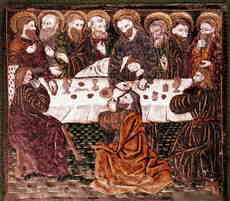
This essay discusses a point quite vital for contemporary theological studies, but unfortunately it cannot possibly endeavor to provide a deep cut of the topic in question, since each particular detail of the relationship of the two Gospels cannot be ascertained with complete confidence. Moreover, these details themselves seem to emerge and vanish stochastically, being dependent almost solely on the researcher's angle of view. Indeed, the Gospel of Thomas from the codices of Nag Hammadi is but a collection of a hundred and fourteen seemingly scattered sayings, whereas the Gospel of John, although compiled so that seams in certain places are evident, is still a flowing narrative.
The question of precedence is crucial in our discussion. It becomes even more significant when one considers the fact that, if the Gospel of Thomas, discovered only in 1945, were indeed older and more authentic than the Synoptics, this would quite upset the modern scholarly views of Christ and the development of early Christianity as a whole ; it is a nonconformist writing without doubt. The question of dependency is still much debated in the scholarly world, and the very question of this essay is further obscured by the fact that the Gospel of Thomas really seems to be in the least connected to the Gospel of John. However, the few traditions that are common to both John and Thomas can enhance our understanding of both Gospels.
Another elaboration is probably necessary: namely, why we think of the Gospel of Thomas as being Gnostic. Wilson points out several important aspects to consider: it was discovered in the library of a Gnostic sect, it was designed as a Gnostic document, it accurately captures the Gnostic environment of the time, etc. At the same time, he indicates that it is also a question of definition: that is, what is meant by the word "Gnostic". I would not go at the length of rethinking the status of the Gospel of Thomas; for the purpose of this essay it will be considered a Gnostic document rather than Christian.
One would hardly argue that all religions have, among other things, one great common keystone in their foundations: they all employ the desire of human being to believe that at least some part of it carries on forever. It seems as though this particular principle was at the core of many early Christian writings, of which the Gospel of Thomas is neither the last nor the least.
It must be stressed that the nature of Gnostic scriptures, as their very name ("gnosis" simply means "knowledge" in Greek, but we traditionally regard it as "hidden knowledge") suggests, has never allowed the documents to be understood by everyone; on the contrary, Gnostic manuscripts are undoubtedly esoteric. This observation is enforced in the first line of the Gospel of Thomas: "These are the hidden sayings (words, logia--S.M.) that the living Jesus spoke and Didymus Judas Thomas recorded". This passage is absolutely remarkable: it openly declares that the manuscript is to be understood only by the chosen (an uninformed person will not comprehend the "hidden sayings"), it also indicates the author (Didymus Judas Thomas), and finally, it suggests the existence of a "twin" ("didymus" and "thomas" are the Greek and Syriac words for "twin"). Many scholars hold that the word "twin" indicates the spiritual (or even family) bond of Jesus and Thomas, their twinship.
This twinship is not explicitly highlighted in John, but the name "Judas" is quite suggestive for the following reason: until now, one has normally come to think only of Judas Iscariot. This name, quite unexpected in this context, then allows for a smooth transition to a remarkable line, John 14:22: "Judas (not Iscariot) said to him: Lord, how is it that you will manifest yourself to us, and not to the world? Jesus answered him: 'If a man loves me, he will keep my word (logos--S.M.)…'" For reasons stated previously, I tend to believe that Judas in this passage actually stands for Apostle Thomas.
However bold this assumption may be , in the light of Gnostic tradition these words take on an astonishing interpretation: only those who keep the word of Jesus will be able to recognize Him when He comes, and the person to take the physical burden of this responsibility is Apostle Thomas. There is not much evidence to support this point, though, and therefore I limit myself to a mere statement of my hypothesis.
Nonetheless, in this context it must be mentioned that there is no cross-Gospel agreement on the names of the Apostles. For instance, Matthean and Markan lists include an Apostle Thaddaeus (or Lebbaeus or Lebbaeus called Thaddaeus) but no Judas, whereas the Lucan listing (and that in the Acts of the Apostles) does include the second Judas, son (or, according to various translations, father) of James, but no Thaddaeus. Nothing can be said about the Gospel of John, though; as we know, it contains no complete record of the identity of the Apostles, and this is yet another point which seems to contribute to the plausibility of my hypothesis. Finally, if, as the next passage shows, we find more evidence to assume that the Gospel of John was much more Gnostic in nature than the Synoptics, it would seem quite a logical connection between the two euangelia.
The next line of the Gospel of Thomas ("Whoever discovers the interpretation of these sayings, will not taste death") again takes us to John, but now to another verse and even another chapter. A sharp reader will nevertheless easily see a link between the two. In John 8:51 we read: "Truly, truly, I say to you, if any one keeps my word, he will never taste death.'" A connection of the Gospels begins to outline more and more intensely. We may try and intensify it even further by drawing attention to the uncharacteristic and atypical beginning of the Gospel of John: "In the beginning was the Word, and the Word was with God, and the Word was God" . This introduction is even more worth of mention if one considers the fact that the notion of Word (Logos) is central to Gnosticism. Montefiore and Turner comment on the style of the Gospel of Thomas saying:
As compared with the Synoptic Gospels the Fourth Gospel recedes into the background, but there is much to be said in favour of the view <…> that if the compiler appears to quote the Synoptics by preference, his style is formed on the Johannine mould. <…> Johannine echoes are richer in those sayings which stand furthest from the canonical tradition.
One of the keywords common to both Gospels is "light". Indeed, we encounter it very often in John (1:4-5, 7-9; 3:19-21; 5:35; 8:12; 9:5; 11:9-10; 12:35-36; 12:46) and in Thomas (11, 24, 33, 50, 77, 83) and not nearly as frequently in the Gospels of Matthew, Mark and Luke. It is also very important that the meaning of this word in the Synoptics is completely different--enlightenment and luminosity. On the contrary, in the Gospels of John and Thomas the word "light" in almost all cases indicates that Jesus is referring to himself (of course, one can easily expand this issue by adding thorny philosophical interpretations ), that is, it bears a significant meaning, captures the substance it describes. Why such a striking difference in the meaning, then?
One reason for that may be the one already described above: that, although textually in certain instances John may be very close to the Synoptics, he shares his approach in depicting Jesus with Thomas. But, on the other hand, this usage of the word "light" is not a mere consequence of the similarity in style; rather, it indicates that the very natures of the two Gospels must be analogous, as opposed to the Synoptics, which may have had different addressees. Wilson writes: "In addition to these similarities between Thomas and Gnostic thought we have to note also a similarity of language, in the use of such terms as 'light'…" , thus confirming my thesis that this word may well serve as an indicator of the audience of the Evangelist.
Saying 50 from the Gospel of Thomas, though considered by many the most enigmatic one, seems to further strengthen the bridge between the two Gospels:
Jesus said, 'If they say to you, 'Where have you come from?' say to them, 'We have come from the light, from the place where the light came into being by itself, established [itself], and appeared in their image.' If they say to you, 'Is it you?' say, 'We are its children, and we are the chosen of the living father.' If they ask you, 'What is the evidence of your father in you?' say to them, 'It is motion and rest.'
This is quite reminiscent of certain verses in John. Meyer points out a connection with John 1:1-5, but although this particular parallel is certainly valid, John 1:4-5 (verses where the word "light" is mentioned) is, in fact, the most general and vague application of this notion. On the contrary, we would like to find something more material, something that would preferably directly indicate the relationship of "light" and "Jesus". In John 8:12 we find: "Again Jesus spoke to them, saying, 'I am the light of the world; he who follows me will not walk in darkness, but will have the light of life." Having this interpretation as an asset, then, we can return to logion 50 of Thomas and try to understand it. "We have come from the light, from the place where the light came into being by itself, established [itself], and appeared in their image" would mean "we are the messengers of Jesus, from the mortal realm where he came into being, established himself and appeared as an earthly entity".
The ending of the logion ("motion and rest") is probably most enigmatic, though; Meyer suggests that this may be an allusion to Genesis in the Old Testament, and I can but agree with him.
Many more interpretations and extensions of this saying have been offered. I cannot possibly cover all of them here; many authors regard logion 50 to be the pivot point of the Gospel, and I am a strong supporter of that position.
The answer to this question, at least at this
stage of the research, is rather "no" than "yes". There are quite a
few suggestive and possibly even conclusive points about the Gospel
of John:
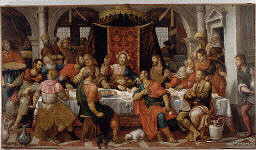 ****
****
- It is the only Gospel from the New Testament where Apostle Thomas plays a major (if not the main) role.
- As I have tried to show, it has a lot of common points with the Gospel of Thomas, points that are very characteristic of Gnosticism and are therefore very unlikely to occur outside of this particular system of beliefs.
- The following argument is made strongly in John: Jesus is the messenger of Light and the Only True Father, whereas common people are children of Devil (Darkness). This is very uncommon for the Synoptic Gospels. Moreover, we may recall that, according to the Gnostic doctrine in particular, Demiurge Yaldabaoth, evil and filthy son of virgin Sophia (and also, possibly, the god of the Hebrew Scriptures), is the actual creator of the world, and people are his atrocious children. This is almost the background setting of the Gospel of John (verse 8:44, "You are of your father the devil, and the desires of your father you will do", is unique to John, just like the whole pericope 8:37-47).
But nevertheless, careful as we must be with misreading and misinterpretations, no conclusions can be drawn with certainty. It is of course very tempting to ascribe all the discrepancies of style and contents to the Gnostic nature of the Gospel of John, but such a deduction would be a blunder to put it mildly. Stace in his Teachings of the Mystics wrote:
When we come to the Gospel of St. John we find that certain mystical-sounding phrases are put into the mouth of Johannine Jesus. He speaks of union with God. <…> But in view of the absence of any of these sayings in the synoptic gospels, we have good reason to believe that the historical Jesus did not utter them, and that they were the work of the author of the fourth gospel <…> Christian mysticism, then, does not begin either with Jesus or with the author of the fourth Gospel.
My perception is rather the opposite. The author's inference seems to me quite faulty: why should we assume that what is written in the Synoptics is indeed an accurate account of the events that took place? The ground for such a surmise is without doubt very shaky, and the question posed by author, then, remains open.
As a conclusion of my essay, I would like to get back to the words of R. Wilson I have quoted in the beginning; as I said, he did not claim with complete confidence that the Gospel of Thomas was a Gnostic document. In fact, even now we are not sure about its "status". And, it would probably be a valid statement to make that comparing John to Thomas might not be such a legitimate measure of John's Gnosticism. I must still say that there are too few typically Gnostic texts to choose from, and the pure Gnostic tradition cannot be considered without some of its transitional stages, so it may be unwise to narrow the field down extremely. It was my desire to show by comparison that the Gospel of John may not be so far from one of such stages after all, and in that the Gospel of Thomas was a most helpful assistant.
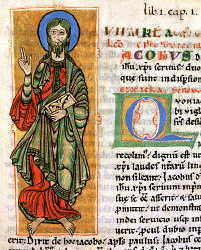
- Aland, K., ed. Synopsis of the Four Gospels. United Bible Societies, 1985.
- De Conick, A. D. Seek to See Him: Ascent and Vision Mysticism in the Gospel of Thomas. Leiden: E. J. Brill, 1996.
- Ehrman, B. D. The New Testament: A Historical Introduction to the Early Christian Writings. New York: Oxford University, 2000.
- Fenton, J. C. The Gospel According to John in the Revised Standard Version. Oxford: Clarendon, 1970.
- Meyer, M. The Gospel of Thomas: the Hidden Sayings of Jesus. San Francisco: Harper, 1992.
- Montefiore, H. and Turner, H. E. W. Thomas and the Evangelists. London: SCM, 1962.
- Patterson, S. J. The Gospel of Thomas and Jesus. Sonoma: Polebridge, 1993.
- Ross, H. McG. Jesus Untouched by the Church. York: William Sessions, 1998.
- Stace, W. T. The Teachings of the Mystics. New York: Mentor Books, 1960.
- Wilson, R. McL. Studies in the Gospel of Thomas. London: A. R. Mowbray & Co., 1960
* Cм. также эссе С.Михайлова:
- "Gospels According to Mark and Matthew Compared" и
- "The Ill-Fated Tool of God Or The Quest For Historical Judas"
*** Новгородская икона с изображением Св. Фомы
**** Фреска выполнена итальянским художником Амальтео Помпоньо (Amalteo, Pomponio (1505-1588))
Отозваться в Бортжурнале
Высказаться Аврально
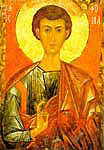 ***
***